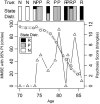A Bayesian model of psychosis symptom trajectory in Alzheimer's disease
- PMID: 26216660
- PMCID: PMC4707989
- DOI: 10.1002/gps.4326
A Bayesian model of psychosis symptom trajectory in Alzheimer's disease
Abstract
Objective: Psychosis, like other neuropsychiatric symptoms of dementia, has many features that make predictive modeling of its onset difficult. For example, psychosis onset is associated with both the absolute degree of cognitive impairment and the rate of cognitive decline. Moreover, psychotic symptoms, while more likely than not to persist over time within individuals, may remit and recur. To facilitate predictive modeling of psychosis for personalized clinical decision making, including evaluating the role of risk genes in its onset, we have developed a novel Bayesian model of the dual trajectories of cognition and psychosis symptoms.
Methods: Cognition was modeled as a four-parameter logistic curve with random effects for all four parameters and possible covariates for the rate and time of fall. Psychosis was modeled as a continuous-time hidden Markov model with a latent never-psychotic class and states for pre-psychotic, actively psychotic and remitted psychosis. Covariates can affect the probability of being in the never-psychotic class. Covariates and the level of cognition can affect the transition rates for the hidden Markov model.
Results: The model characteristics were confirmed using simulated data. Results from 434 AD patients show that a decline in cognition is associated with an increased rate of transition to the psychotic state.
Conclusions: The model allows declining cognition as an input for psychosis prediction, while incorporating the full uncertainty of the interpolated cognition values. The techniques used can be used in future genetic studies of AD and are generalizable to the study of other neuropsychiatric symptoms in dementia.
Keywords: Alzheimer's disease; cognitive impairment; neuropsychiatric symptoms.
Copyright © 2015 John Wiley & Sons, Ltd.
Figures
References
-
- Ghosh SK, Mukhopadhyay P, Lu JC. Bayesian analysis of zero inflated regression models. J Stat Plan Inference. 2006;136:1360–1375. doi: 10.1016/j.jspi.2004.10.008. - DOI
Publication types
MeSH terms
Grants and funding
LinkOut - more resources
Full Text Sources
Other Literature Sources
Medical



